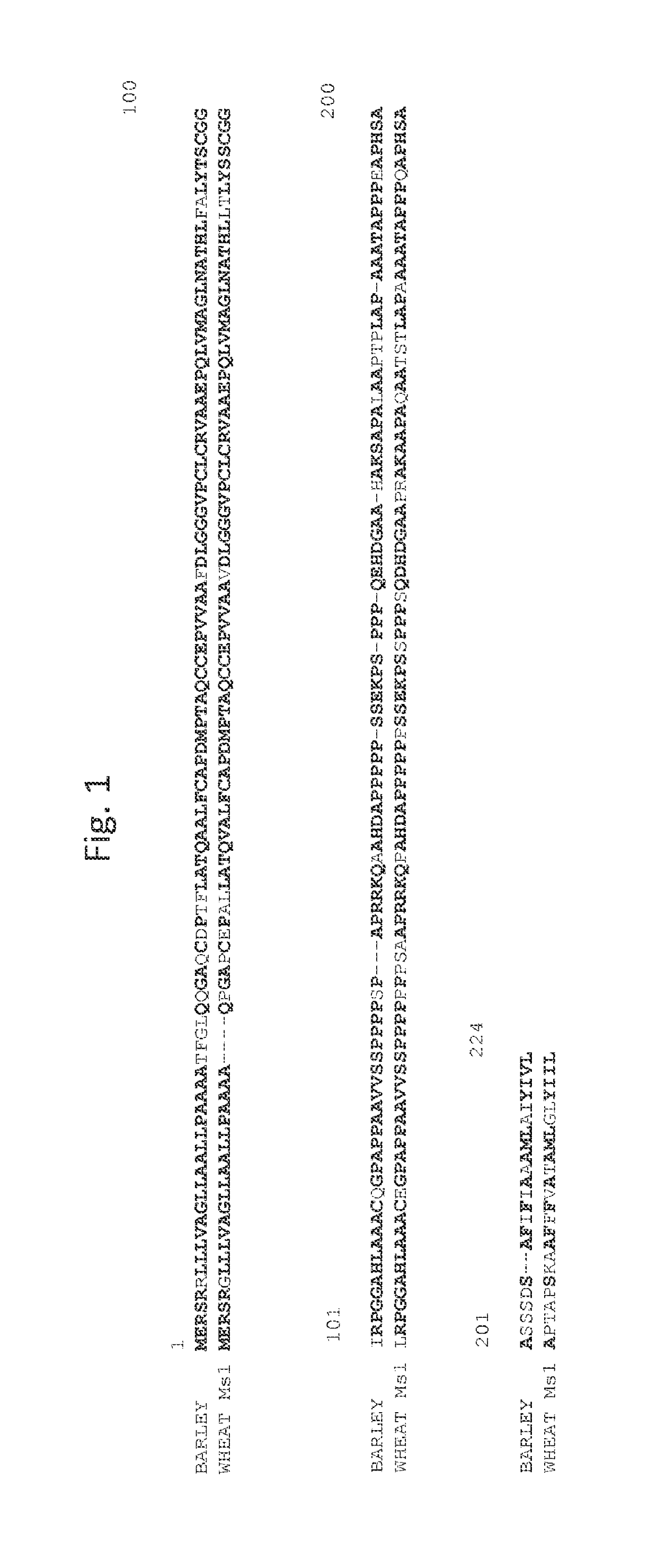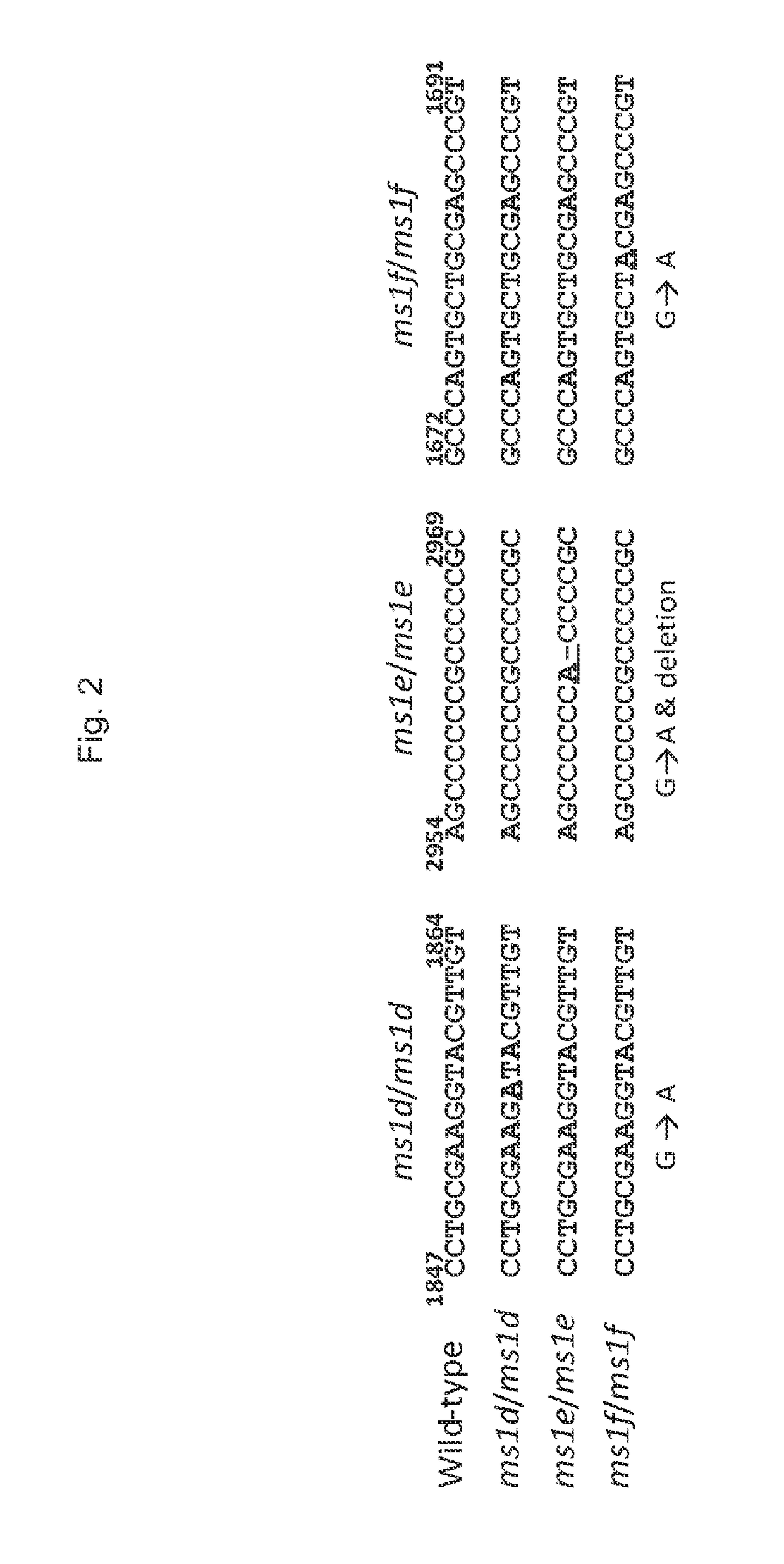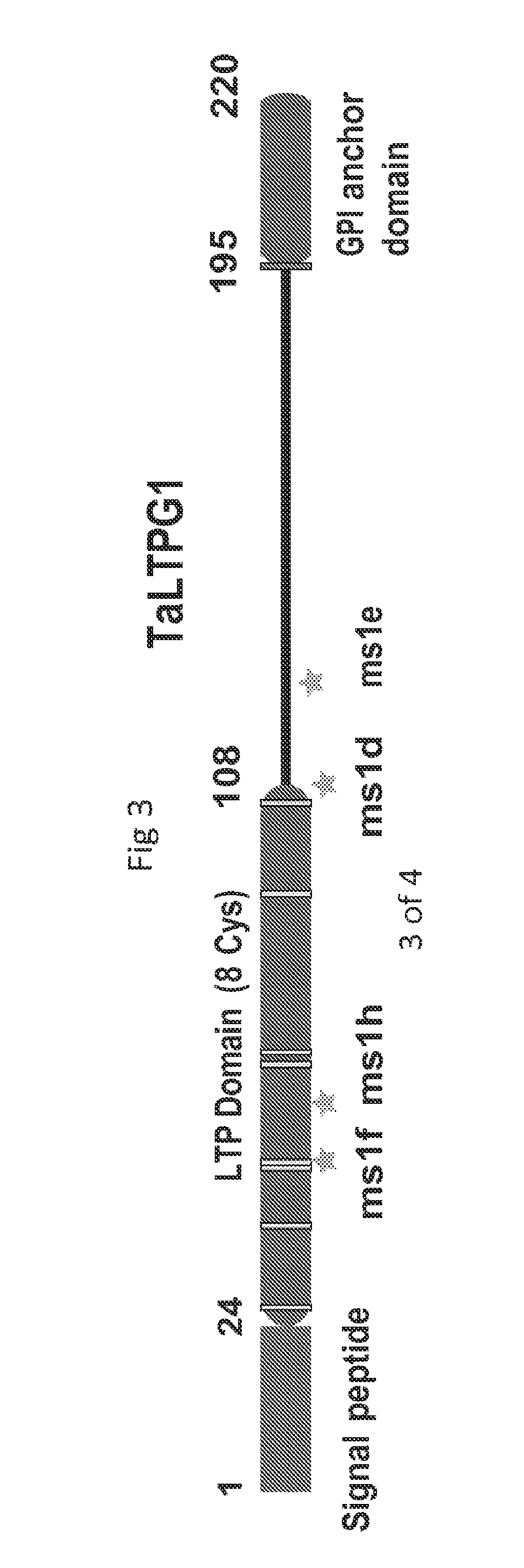Wheat ms1 polynucleotides, polypeptides, and methods of use
a polypeptide and ms1 technology, applied in the field of plant molecular biology, can solve the problems of significant obstacles such as hexaploidy, and achieve the effect of modulating male fertility
- Summary
- Abstract
- Description
- Claims
- Application Information
AI Technical Summary
Problems solved by technology
Method used
Image
Examples
example 1
Genetic Mapping of Ms1.
[0159]This example demonstrates that by using recombinant mapping populations of wild-type and male-sterile wheat, the causative locus for the male-sterile phenotype of wheat ms1 can be mapped to a 1 cM region on the short arm of chromosome 4 of the B genome. A male sterile (msms) alloplasmic wheat, var. Chris, carrying the FS2 mutant gene (also referred to as ms1d) was crossed to a plant of variety Gladius to create an F2 mapping population. Sequences in the Ms1 region on chromosome 4B S were identified based either on synteny with wheat chromosome 4AL (Hernandez et al. 2011. Plant Journal 69(3):377-386), barley chromosome 4HS (Mayer et al. 2011. Plant Cell 23(4):1249-1263), Brachypodium chromosome 1 and rice chromosome 3, or bin mapped wheat ESTs (Sorrells et al., 2003 Genome Research 13:1818-1827; La Rota & Sorrells, 2004 Funct Integr Genomics 4: 34-46). Corresponding wheat sequence contigs from reference syntenic sequences (e.g. barley SNP marker 11_21056,...
example 2
Identifying 4BS BACs for Sequencing of Ms1
[0164]Eighteen probes were designed within the 0.5 cM region bounded by markers wsnp_Ex_c18318_27140346 (SEQ ID NO:18) and wsnp_Ku_c7153_12360198 (SEQ ID NO:21), using synteny to Brachypodium and rice. Probes were designed to be non-repetitive based on BLAST analysis of target sequences. Probes were then PCR amplified and separated by agarose gel electrophoresis with fragments of desired size being eluted from the gel using Qiaquick Gel Extraction kit (Qiagen, Germantown, Md., USA). PCR fragments were pooled to an equimolar concentration then 32P-dATP radio-labeled by NEBlot kit (New England Biolabs) using manufacturer's protocol. The labeled probe was purified in a Sephadex G50 column (GE Healthcare) and denatured at 100° C. for 10 min. Twenty eight high-density BAC clone colony filters gridded onto Hybond N+nylon membranes (GE Healthcare, Piscataway, N.J., USA) were used for hybridization. This represents a coverage of 5.1-genome equivalen...
example 3
Identification of Candidate Ms1 Gene
[0166]Ten potential coding regions were detected within the 251 kB sequence by mapping cDNAs derived from wheat root, leaf and anther tissues. Table 2 provides the physical position of the 10 likely coding sequences plus their putative peptide function.
TABLE 2functional sequence orien-annotationgenesimilaritycoordinatestation(Brachypodium)1Bradi1g12960.111658sensepartial gene;unknown2Bradi1g12970.137484252antisenseN-acetyltransferase3Bradi1g12980.12186723596senseparafibromin4Bradi1g12990.12642426660antisenseLTPL715Bradi1g13000.12869729260antisenseLTPL72ubiquitin-protein6Bradi4g44760.13064932207antisenseligase7Bradi1g69240.13043630612senseFbox / LRR domain8Bradi1g13030181034181291senseLTPL949Bradi2g05445.1210365218154antisense60S ribosomalprotein10Bradi1g13040227961230664antisenseglobulin—Cupin
[0167]Among the 10 open reading frames, three encoded polypeptides with similarity to non-specific lipid transfer proteins (nsLTPs) (Edstam et al., 2014 Physio...
PUM
| Property | Measurement | Unit |
|---|---|---|
| pH | aaaaa | aaaaa |
| accelerating voltage | aaaaa | aaaaa |
| accelerating voltage | aaaaa | aaaaa |
Abstract
Description
Claims
Application Information
 Login to View More
Login to View More - R&D
- Intellectual Property
- Life Sciences
- Materials
- Tech Scout
- Unparalleled Data Quality
- Higher Quality Content
- 60% Fewer Hallucinations
Browse by: Latest US Patents, China's latest patents, Technical Efficacy Thesaurus, Application Domain, Technology Topic, Popular Technical Reports.
© 2025 PatSnap. All rights reserved.Legal|Privacy policy|Modern Slavery Act Transparency Statement|Sitemap|About US| Contact US: help@patsnap.com



